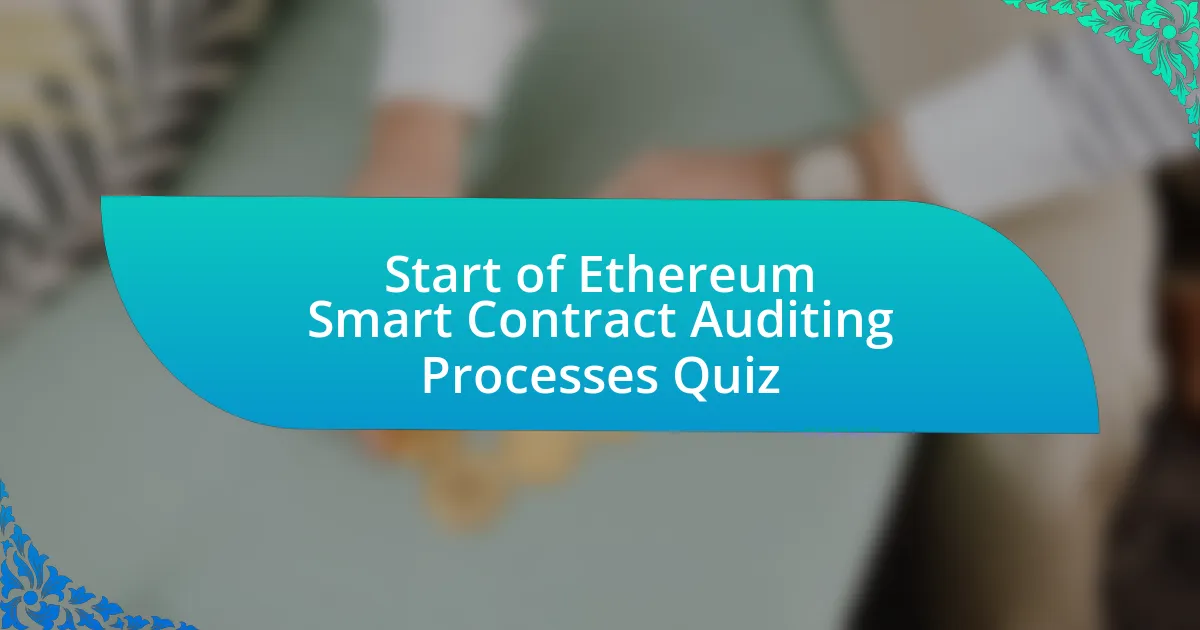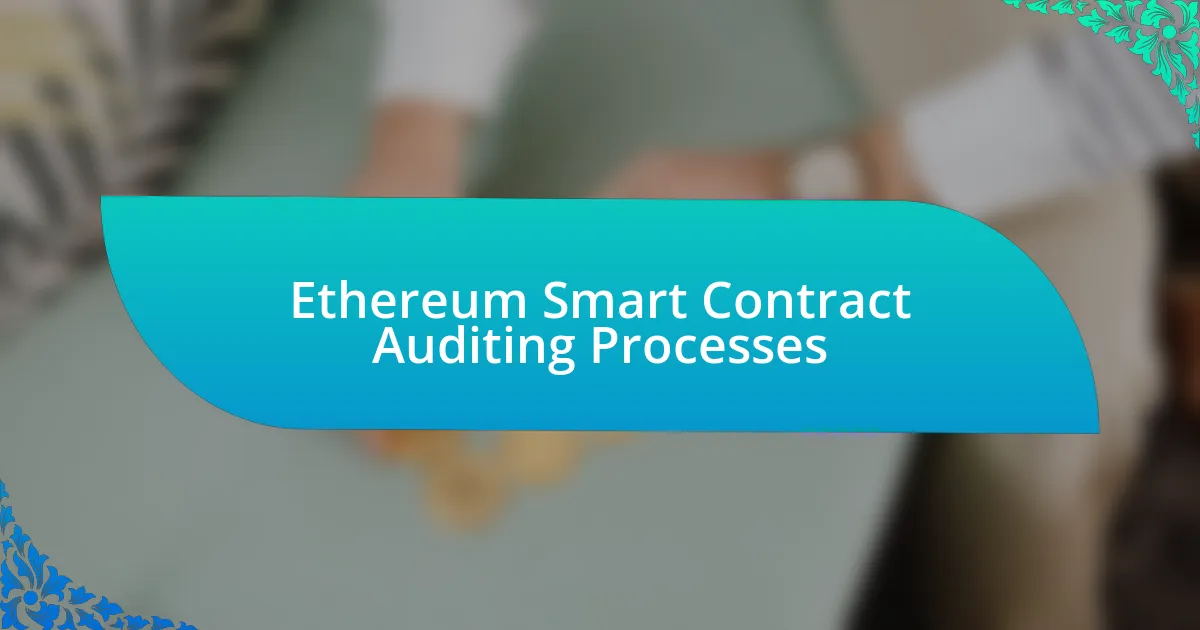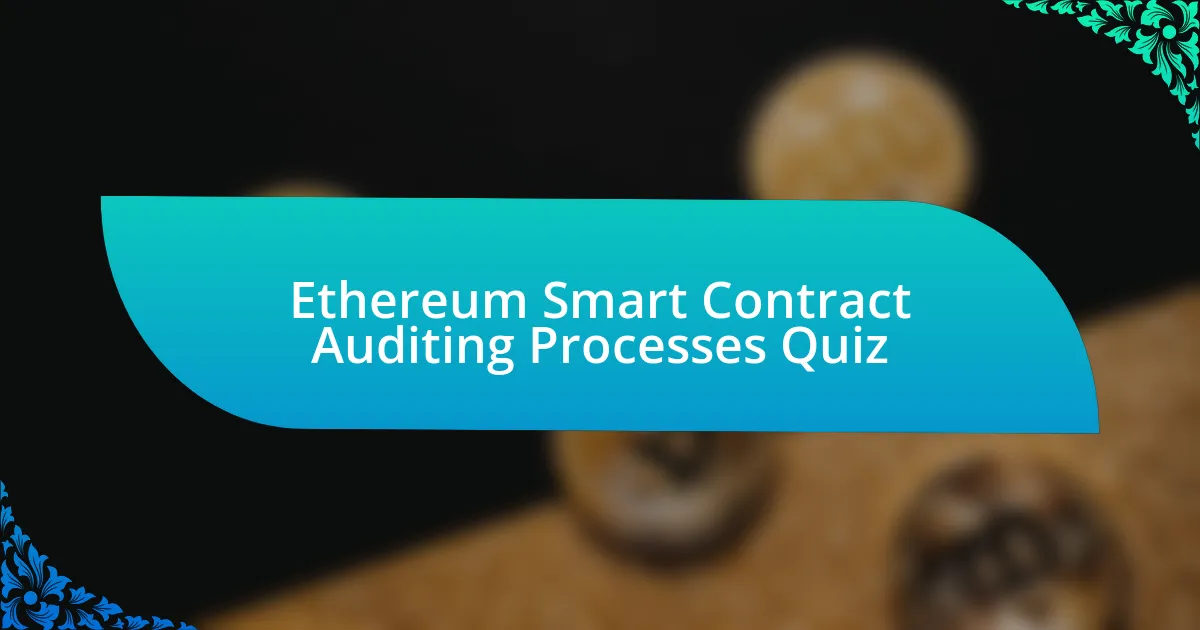
Start of Ethereum Smart Contract Auditing Processes Quiz
1. What is the primary objective of auditing Ethereum smart contracts?
- To identify and mitigate vulnerabilities in smart contracts.
- To enhance the aesthetic design of the contract`s code.
- To promote the smart contract to users.
- To increase the transaction speed of the network.
2. What essential materials should developers provide to auditors for an effective audit?
- Marketing materials and promotional content.
- Technical documentation, including the codebase, whitepaper, architecture, and any other related material.
- Financial reports and balance sheets.
- Personal identification documents of the developers.
3. In smart contract auditing, what does the term `automated testing` refer to?
- Automated testing checks every possible state of a smart contract and raises alerts around issues that could undermine the contract’s functionality or security.
- Automated testing focuses solely on user interface elements of smart contracts.
- Automated testing manually inspects individual code lines without using software tools.
- Automated testing randomly selects transactions to analyze for errors and flaws.
4. How are vulnerabilities in smart contracts categorized by severity?
- Critical, Major, Medium, Minor, or Informational
- Severe, Moderate, Negligible
- High, Moderate, Low
- Extreme, Average, Basic
5. What function does formal verification serve in the auditing of smart contracts?
- Formal verification checks every possible state of a smart contract using mathematical guarantees to ensure the contract behaves as intended.
- Formal verification generates random testing scenarios without any mathematical backing.
- Formal verification allows the smart contract to automatically update for any changes made.
- Formal verification provides only basic code formatting and comments for clarity.
6. Why is an initial report crucial in the auditing process of smart contracts?
- The initial report discusses marketing strategies for the smart contract.
- The initial report lists potential users and their demographics.
- The initial report summarizes code flaws and other issues, along with feedback on how the project’s team can fix them.
- The initial report solely focuses on financial projections and outcomes.
7. What does a code freeze achieve during the audit of a smart contract?
- It ensures that the code being audited is stable and not subject to changes during the audit process.
- It encourages frequent code updates for better security.
- It allows for the integration of new features during the audit process.
- It facilitates the immediate deployment of the contract after the audit.
8. What tools are typically utilized in the auditing of smart contracts on Ethereum?
- Social media platforms, gaming tools, and graphics libraries are commonly used.
- Programming languages, compilers, and debuggers are commonly used.
- Cloud services, databases, and web servers are commonly used.
- Automated testing engines, formal verification tools, and security checklists are commonly used.
9. How does a detailed smart contract audit checklist enhance the auditing process?
- A comprehensive checklist ensures a holistic approach to smart contract auditing by covering all critical aspects of the contract.
- A comprehensive checklist guarantees that no vulnerabilities exist within the smart contract.
- A comprehensive checklist helps in limiting the number of auditors involved in the process.
- A comprehensive checklist simplifies the coding process by removing unnecessary code.
10. Why are community-driven checklists important in the context of smart contract auditing?
- Community-driven checklists are created by a single auditor, which limits their effectiveness and relevance.
- Community-driven checklists are focused solely on coding standards without addressing security concerns.
- Community-driven checklists are not shared publicly, reducing collaboration among developers.
- Community-driven checklists are open for contributions, ensuring they are always up-to-date with the latest vulnerabilities and best practices.
11. What types of accounts exist within the Ethereum network?
- Secure Accounts and Insecure Accounts.
- User Accounts and Admin Accounts.
- Externally Owned Accounts (EOAs) and Contract Accounts.
- Private Accounts and Public Accounts.
12. What is the role of a nonce in Ethereum transactions?
- To encrypt the transaction data for security.
- To increase transaction fees for faster processing.
- To determine the validity of the smart contract.
- To prevent message replay by ensuring each transaction can only be processed once.
13. What information is inaccessible within the Ethereum Virtual Machine (EVM)?
- Ownership of tokens and user wallet balances.
- Caller address and msg.sender details.
- Transaction timestamps and block numbers.
- Smart contract size limitations and total supply.
14. What motivates miners to engage in block validation and creation?
- Block rewards and transaction fees.
- Social recognition and community support.
- Free equipment and tools.
- Travel opportunities to mining hot spots.
15. Is it permissible for any individual to deploy a smart contract on Ethereum?
- No, only registered developers can deploy smart contracts on Ethereum.
- Yes, but only if they have advanced coding skills.
- Yes, anyone can deploy smart contracts on Ethereum.
- No, only government-approved entities can deploy smart contracts on Ethereum.
16. Why are security audits vital for Ethereum smart contracts?
- To increase the transaction speed of smart contracts.
- To generate automated code without any review.
- To help remove vulnerabilities and reduce risk.
- To allow any developer to deploy unlimited contracts.
17. How do advanced AI technologies contribute to the smart contract auditing process?
- Advanced AI eliminates the need for any human auditors in the process.
- Advanced AI provides an additional layer of security by automating the review process.
- Advanced AI creates smart contracts without human input.
- Advanced AI solely focuses on marketing smart contracts to investors.
18. In what way does formal verification ensure the expected behavior of smart contracts?
- Formal verification relies on user testing to find bugs in smart contracts.
- Formal verification tests smart contracts by running them in a simulated environment.
- Formal verification ensures smart contracts are audited by multiple auditors for accuracy.
- Formal verification uses mathematical proofs to confirm smart contract behavior.
19. Why is the use of SafeMath necessary in Solidity contracts?
- It maximizes gas consumption for operations.
- It is necessary for variable declarations only.
- It helps prevent arithmetic overflows and underflows.
- It increases the complexity of the contracts.
20. What pitfalls should developers avoid when working with Solidity storage slots?
- Reading storage slots multiple times.
- Writing to multiple slots at once.
- Using constant storage variables.
- Ignoring storage updates.
21. What can lead to a denial-of-service (DoS) condition in smart contracts?
- Unbounded loops or arrays.
- Insufficient gas fees.
- Weak password management.
- Excessive variable declarations.
22. How should the `block.timestamp` function be effectively utilized in smart contracts?
- Only for long intervals.
- Only for short durations.
- To track state changes.
- For any time in between.
23. What is a recommended practice regarding `block.number` in Ethereum smart contracts?
- Avoid using it for elapsed time.
- Use it as a random number generator.
- Rely on it for block validation.
- Use it for transaction fee calculations.
24. Why is the `delegatecall` function regarded with caution in smart contracts?
- It requires higher gas fees than standard functions.
- It can lead to unexpected behavior when interacting with external contracts.
- It is known for improving transaction speeds significantly.
- It simplifies function calls across different contracts.
25. What considerations should be taken when modifying array lengths in smart contracts?
- Updating it while iterating over it.
- Changing it in another smart contract.
- Modifying it without validation checks.
- Allowing direct external access to it.
26. Why are functions like `blockhash()` unsuitable for randomness in smart contracts?
- Because they require too much gas to execute.
- Because they can be manipulated by miners.
- Because they are always random and unpredictable.
- Because they are too costly to compute on-chain.
27. What makes a structured auditing approach significant in assessing smart contracts?
- It focuses solely on aesthetic improvements of the code.
- It permits unlimited changes to the smart contract during the audit.
- It ensures that all critical aspects of the contract are reviewed systematically.
- It minimizes the need for technical documentation during review.
28. How does a standardized checklist enhance teamwork in smart contract audits?
- By ensuring all critical aspects are reviewed systematically.
- By reducing the need for documentation and communication.
- By allowing multiple teams to work independently without coordination.
- By increasing the chances of overlooking important issues.
29. What is the goal of improving security maturity in the blockchain arena?
- To simplify the coding process for smart contracts.
- To reduce the number of nodes required for network stability.
- To ensure that security protocols around blockchain projects mature as the ecosystem evolves.
- To increase transaction speeds and lower costs for users.
30. Why would one prefer to view an audit checklist in raw JSON format?
- To compress data for faster loading times.
- To enhance visual appearance for manual reviews.
- To allow for easy customization and integration into automated analyzers.
- To provide a user-friendly interface for auditors.

Congratulations! You Have Successfully Completed the Quiz
Thank you for participating in our quiz on Ethereum Smart Contract Auditing Processes. We hope you found the questions engaging and informative. This exercise not only tested your knowledge but also deepened your understanding of how auditing ensures the security and efficiency of smart contracts. Many learners discover key concepts like vulnerability identification and the importance of thorough testing.
By completing this quiz, you likely gained insights into common auditing practices and the tools used in the industry. Understanding the role of audits can empower you to develop more secure smart contracts. This knowledge is crucial in the rapidly evolving landscape of blockchain technology, where security holds immense value.
If you’re eager to further expand your understanding, we invite you to explore the next section on this page. Our detailed content on Ethereum Smart Contract Auditing Processes delves deeper into best practices, methodologies, and case studies. Engaging with this material will enhance your expertise and prepare you for future challenges in the blockchain space.

Ethereum Smart Contract Auditing Processes
Understanding Ethereum Smart Contracts
Ethereum smart contracts are self-executing contracts programmed to automatically enforce and execute contractual agreements. They operate on the Ethereum blockchain, utilizing the Ethereum Virtual Machine (EVM) to process transactions and maintain data integrity. Smart contracts eliminate the need for intermediaries, reducing costs and enhancing efficiency. The code within a smart contract specifies the rules and consequences of the agreement, ensuring transparency and security. As of 2023, millions of smart contracts are deployed on the Ethereum network, underlying various decentralized applications (dApps) and financial services.
The Importance of Smart Contract Auditing
Auditing smart contracts is crucial to ensuring their security and functionality before deployment. This process involves a thorough examination of the contract’s code to identify vulnerabilities, bugs, and logical flaws that could lead to financial losses or exploits. Given that smart contracts are immutable once deployed, finding and fixing issues before they go live is vital. The increasing prominence of DeFi (Decentralized Finance) and NFTs (Non-Fungible Tokens) has heightened the necessity for reliable auditing to protect users and assets from potential risks.
Common Vulnerabilities in Smart Contracts
Smart contracts often face several vulnerabilities that auditors must recognize and mitigate. Some common issues include reentrancy attacks, where a malicious contract calls back into the original contract and alters state variables. Another is integer overflow or underflow, which can lead to unexpected behaviors in calculations. Access control issues arise when unauthorized parties can execute sensitive functions. Additionally, improper error handling can result in system failures. Recognizing these vulnerabilities is essential for effective auditing and ensuring contract security.
Smart Contract Auditing Tools and Techniques
Various tools and techniques assist in conducting smart contract audits. Static analysis tools like Mythril and Slither analyze the code without executing it, identifying common vulnerabilities early in the development process. Dynamic analysis tools, such as Echidna, execute the contract to observe behaviors under various conditions. Manual code reviews complement automated processes, allowing auditors to catch contextual issues that tools might miss. Together, these approaches create a robust auditing framework that enhances contract reliability and security.
Best Practices for Conducting an Audit
Conducting a smart contract audit involves several best practices. First, establish a thorough audit plan detailing the scope and objectives. Engage multiple auditors to provide diverse perspectives and ensure comprehensive coverage. Maintain clear documentation of findings and recommendations to facilitate improvements. Implement a test suite to validate contract functionality and security pre-launch. Lastly, adopt a continuous monitoring approach post-deployment to address any emerging vulnerabilities proactively. These practices help enhance the overall reliability of the smart contract system.
What are Ethereum smart contract auditing processes?
Ethereum smart contract auditing processes involve a series of systematic evaluations conducted to ensure the functionality, security, and reliability of smart contracts deployed on the Ethereum blockchain. These processes typically include manual code reviews, automated testing with tools, vulnerability assessments, and performance analysis. According to a study from ConsenSys, about 60% of all audits identify vulnerabilities that could be exploited.
How are Ethereum smart contracts audited?
Ethereum smart contracts are audited through a combination of code inspection, automated analysis tools, and testing frameworks. Auditors manually review the code for logical errors, and then utilize tools like Mythril or Slither for identifying vulnerabilities. A report is generated detailing the findings, risks, and suggested fixes. As reported by various blockchain security firms, more than 70% of vulnerabilities can be caught through automated tools during the audit process.
Where can Ethereum smart contracts be audited?
Ethereum smart contracts can be audited by specialized blockchain security firms, freelance auditors, or auditing platforms dedicated to smart contract security. Notable firms like Quantstamp and OpenZeppelin provide auditing services for smart contracts. The Ethereum community frequently emphasizes the importance of third-party audits to bolster trust, with a notable increase in engagements with such firms over the years.
When should Ethereum smart contracts be audited?
Ethereum smart contracts should be audited before their deployment to the mainnet, after significant code changes, and periodically for ongoing projects. The Ethereum Foundation recommends conducting audits prior to any public release to mitigate risks. In practice, over 80% of high-value projects schedule audits before launching to protect financial and reputational stakes.
Who conducts Ethereum smart contract audits?
Ethereum smart contract audits are conducted by specialized auditors, security firms, and independent experts who have experience in blockchain technology. These professionals possess a deep understanding of smart contract code and its security implications. Many auditing teams include certified blockchain developers and security analysts, ensuring a comprehensive review process. According to the statistics, more than 50 specialized firms around the world are dedicated to smart contract audits.

